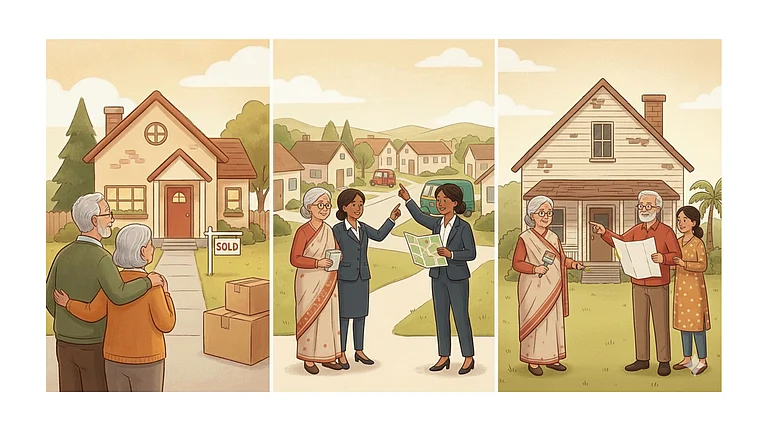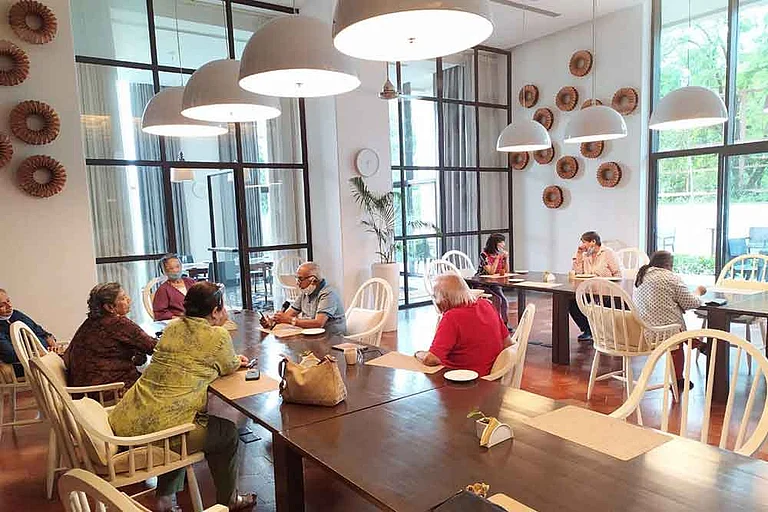Co-living retirement homes foster a sense of community and preserve the tradition of living in a joint family. This made-up joint family is a little different from a typical family as it is made up of members who are all senior citizens. This type of retirement home not only helps seniors stay involved in society but also helps them make friends, do group activities, connect and make meaningful relationships.
Imagine that in the heart of Bengaluru, there is a woman of 72-year-old Shobha Khare who shares a spacious apartment with two other women in their seventies. Their days are filled with laughter over morning tea, and group yoga sessions along with shared responsibilities. There is a new trend in India where elderly individuals opt for communal living to combat loneliness and ensure mutual support instead of living independently in a retirement home and being isolated from others.
Understanding Senior Co-Living
Senior co-living is a housing model where older adults live together in shared spaces, maintaining their independence while benefiting from community support. Unlike conventional old-age homes, these setups emphasize autonomy, companionship, and shared responsibilities, often facilitated by private developers or community initiatives.
Through co-living, senior people get to know each other and connect on a personal level. It creates an environment like a family. Living a monotonous life in retirement may even cause a person to crave the chaos of a home where arguments take place and people gather in one room to talk about similar interests.
Benefits of Co-Living for Seniors
Co-living option for seniors offers various benefits which are:
Combating Loneliness: There has been a significant increase in the number of nuclear families in India. Also, there are many families where children move abroad for education or permanently due to jobs. This shift has made many seniors face isolation. Co-living offers daily social interactions and encourages mental well-being.
Shared Expenses: Those with low income or a limited corpus can benefit from a co-living situation. Pooling resources for rent, utilities, and groceries is a good way to save money. Shared financial burden makes living more affordable, especially for those on fixed pensions.
Safety and Support: Living with peers ensures immediate assistance during emergencies. It also leads to the enhancement of a sense of security.
Active Lifestyle: Group activities like gardening, book clubs, and fitness classes promote physical health. They also promote mental stimulation thus helping seniors combat mental issues or illnesses.
Operational Dynamics: How Does Co-Living Works
Co-living arrangements for seniors typically involve:
Shared Spaces: Co-living provides private bedrooms. It also offers communal areas like kitchens, living areas, and gardens depending on the size of the facility.
Community Guidelines: There are pre-agreement rules regarding chores, and expenses to avoid overburdening one person. It also offers guest policies to ensure harmony.
Facilitators: When many people live together, there can be conflicts and chaos. Some setups have coordinators to manage logistics, and mediate these conflicts, as well as organize activities.
Healthcare Access: Co-living houses are made within proximity to clinics or have tie-ups with healthcare providers for regular check-ups and emergencies.
Evaluating the trend: Fad or Future?
According to JLL, a real estate company, India's senior population is projected to double from 156.7 million in 2024 to 346 million by 2050, making it the world's second-largest elderly population. This demographic shift, combined with changing family structures like joint family to nuclear demands alternative care facilities for seniors. Increased life expectancy also calls for the need for alternative solutions.
Reports of JLL, the 5th ASLI ageing fest also indicate that the senior living housing sector in India is expected to skyrocket over 300 per cent by 2030, reaching USD 7.7 billion (INR 64,500 crore). Such growth suggests that senior co-living isn't just a passing trend but a viable, long-term solution to address the evolving needs of the elderly.
The Indian Landscape: Growth and Potential
Southern India, particularly cities like Bengaluru, Chennai, and Coimbatore, has emerged as a hub for senior living projects, accounting for nearly 60 per cent of the market share. Factors such as early adoption of senior living concepts, cultural acceptance, and a significant Non-Resident Indian (NRI) population investing in these projects contribute to this regional dominance.
Moreover, the market penetration for senior living facilities in India currently stands at just 1.3 per cent, indicating vast untapped potential compared to mature markets like the United States and Australia, where penetration rates exceed 6 per cent.
Legal, Health, and Financial Implications of Co-Living Retirement Homes
1. Legal Considerations:
The lack of specific laws for the senior housing sector results in facilities operating without sufficient oversight, and there are no standardized guidelines for healthcare, security, or recreational facilities. Legal issues surrounding property ownership, inheritance, and elderly individuals' rights can complicate co-living arrangements.
2. Health Implications:
Luxury communities often provide round-the-clock healthcare, but smaller, budget-friendly facilities often lack the necessary staff or infrastructure for emergencies. Co-living, on the other hand, can reduce feelings of isolation and depression among seniors through its communal nature.
3. Financial Aspects:
Co-living offers cost-effective alternatives to traditional senior care, with shared expenses. The growing demand in India's senior living market is expected to reach USD 12 billion by 2030, attracting institutional investors.
Embracing a Collaborative Future
As India grapples with the challenges of an aging population, senior co-living emerges as a promising solution that combines independence with community support. While there are hurdles to overcome, particularly in legal and healthcare frameworks, the benefits of such arrangements are evident. By fostering companionship, ensuring safety, and promoting active lifestyles, co-living offers seniors a dignified and fulfilling way to navigate their golden years.



















